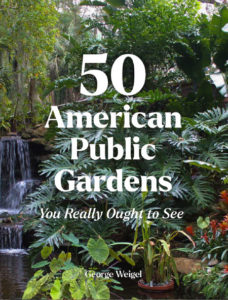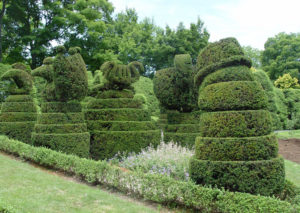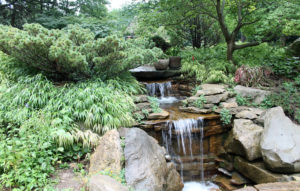50 American Public Gardens You Really Ought to See
February 16th, 2021
I love public gardens. I’ve seen hundreds of them across America as well as Canada, Europe, the Caribbean, and as far away as the other-worldly Kirstenbosch Botanical Garden in Cape Town, South Africa.
Lots of you have gone on our Lowee’s and Collette tours to many of them, so I know I’m not the only one who’s drawn like a magnet to these botanical gems.
People sometimes ask me which gardens are my favorites. That’s a tough question. They all have their own distinct appeals.
Since last year was a washout for travel, I did some thinking and dreaming instead and came up with a list of my 50 favorite American public gardens – in order.
With the help of my designer daughter Erin, I put them into an e-book with one-page profiles of each garden.
The profiles feature overviews and highlights of each garden, location and contact information, two photos of each garden, and a “George’s Take” look at what stood out most to me at each place.
The “50 American Public Gardens You Really Ought to See” e-book is available now as a $7.95 download on my Buy Helpful Info page.
Besides their sheer beauty, public gardens are an excellent resource to introduce gardeners (and future gardeners) to plants they’ve never seen. Gardens nearby or in similar climates are especially useful for giving ideas on what plants will work at home and how to use them.
Maybe best of all, we get to enjoy the plants, gardens, and color without having to yank weeds, edge the beds, or prune the hedges. Staff takes care of that. Our contribution is just to savor.
One of the things I like best is that every garden has its own specialty, focus, twist, or “personality.”
Most of them have some sort of signature feature, too – an element that stands out in the memory, such as the ginormous lighted water fountains at Longwood Gardens, the topiary foxhunt scene at Maryland’s Ladew Topiary Gardens, or the 205-foot-tall, pinkish marble and coquina monument with carillon that’s the centerpiece of Bok Tower Gardens in central Florida.
Some places are former estates that exist to pass a horticultural masterpiece into posterity. Delaware County’s Chanticleer, for example, is a pharmaceutical magnate’s “pleasure garden” that doesn’t even label the exquisite plant collection in its 30 acres.
Others are true botanical gardens with collections of magnolias, conifers, roses and such, and loads of educational signs – Latin names and scientific lineage at no extra charge.
My list turned out to include a mix of our widely acclaimed public gardens but also a lot that “fly below the radar” when it comes to notoriety. I’ll bet there are some on my top-50 list that you’ve never heard of.
That’s one of the ideas behind why I compiled the e-book – to shed light on some really spectacular places that deserve broader recognition.
Another purpose is to get you thinking about some of the gardens you’ve seen and how you’d rank them. Odds are that your list will be different from the ones I like the best. After all, gardens are highly subjective.
Third, the e-book might help you make a wish list of must-see gardens once we’re all able and comfortable to freely travel again.
One of the advantages of public gardens is that they’re mostly outside. Between that and the timed-ticketing limits and mask-wearing rules that almost all public gardens enacted, public-garden visiting has one of the safer anti-cabin-fever options we’ve had during the COVID pandemic.
Before you visit any of the gardens, be sure to check ahead for visitation rules and to make sure the garden is open. Some gardens are open seasonally, while others aren’t open every day, or they close on certain holidays or special occasions.
After you check out my top-50 list, which is based only on U.S. gardens and ones I’ve visited, let me know if I’m missing any of your favorites.
I’m still working on my bucket list.










